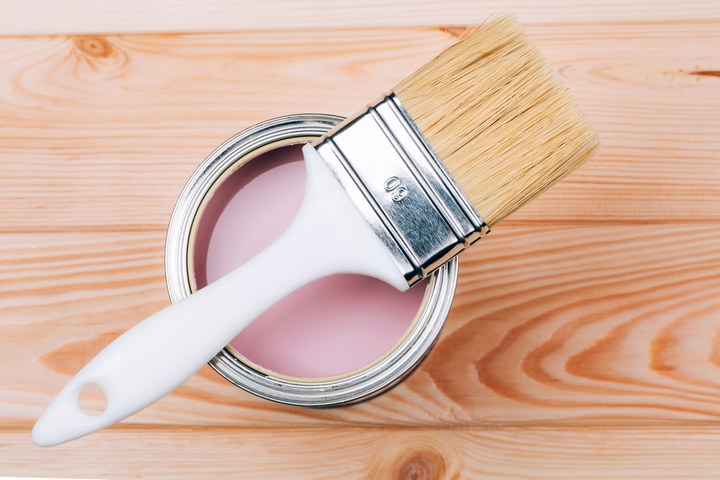A popular technique for creating a soft texture is sponge painting. This technique is great for hiding imperfections and blemishes.
Striping
Striping is a popular wall painting technique that adds depth and elegance to rooms. It is also a creative way to play with color combinations and thicknesses. While striped walls are more challenging to paint than a solid color, they can be done by following a few simple steps. It is important to select a pattern and colors before starting the project. This will ensure that the stripes match and don’t clash. Once the design is set, it is time to prepare the wall for painting. To remove dirt and dust, dampen a sponge or cloth with water and mild dishwashing soap and clean the walls to be painted. Next, protect any woodwork or trim that will not be painted by applying a thin coat of painter’s tape to the area. Finally, apply a base coat of the existing wall color to seal the surface and prevent bleed under the tape.
Painting walls might seem easy, but professional painter brisbane have many different techniques. Before a painter begins, they usually protect the floor and furniture with drop cloths, cover switches and outlets, and tape off areas not to be painted.
Use a yardstick to mark the horizontal or vertical line where each stripe is located. The lines should be placed at even intervals around the room. When painting vertical stripes, start by measuring from the ceiling to the top of the wall and then repeating the measurement along the bottom edge of the room. For horizontal stripes, mark a spot every inch or so depending on how wide you want your stripes to be. When the marks are marked, place painters tape over the pencil lines and carefully press the tape down to create an even stripe border.
It is recommended to apply a basecoat of the dark wall colour to the entire surface. Let it dry. This will create a smooth, even surface to apply your contrasting stripe colour. After the first coat has dried, use a rolling pin to apply the color of the stripe. Remember to remove the tape carefully while it’s still tacky in order to avoid leaving any marks.
Ombre
Ombre is a popular paint technique that creates a gradient effect between similar colors. It’s easy to use and adds a touch of elegance to any space. This style is also an excellent way to dress up a focal wall and make it stand out. The key to successful ombre painting is blending the different colors evenly. This is an important step for a polished finish, but it’s also difficult to do without practice. This is why it’s best to do a test run on a separate surface before attempting this project on your walls.
Start by selecting your desired color scheme. There are many options from subtle transitions, to bold contrasting colors. Once you’ve chosen your colors, it’s now time to start the ombre process. Begin by applying painter’s tape to the trim, ceiling, and adjacent walls if necessary. To prepare the wall for painting, dust or wipe it down. This will remove any lingering dirt or debris and help you achieve a smooth and even finish. Cover any furniture or flooring in a plastic dropcloth to protect it from painter’s tap and paint.
Begin with the lightest shade of paint. Apply the color to a section of the wall and use a brush or roller to blend it evenly into the adjacent areas. This is the most time-consuming part of the ombre painting process, but it’s essential to get it right. If you don’t blend these two sections properly, the ombre will appear uneven and sloppy.
After the first color has dried, you can apply the second. Repeat the blending procedure, but use a darker color of paint. Keep the same angle of blending as the previous section. Once the second section has dried, paint the final color on top of the wall. Blend again, if needed, to achieve a seamless finish.
This is a quick and easy paint job, but requires some planning. You’ll also need a paint tray, mixing palette and painters tape. It’s also a good idea to use oil-based paints, as they will dry slower than latex.
Stencils
Stencils add a lot of personality to walls. They are often used to accent a focal wall, or to complement other elements in the space. Many different stencil designs are available, so you can choose a pattern that fits your space and style. Stencils for walls can be large, such as a damask, or smaller, such as stand-alone flowers and leaves. Regardless of the size, it’s important to choose a quality stencil that will hold up well to repeated applications.
When using a stencil, it’s best to start with a clean surface and to apply a thin coat of paint over the area that you plan to stencil. This will help prevent the stencil from lifting as you work. You should also be sure to tape the edges of the stencil, as well as any adjacent surfaces such as trim or baseboards. This will ensure that the stencil does not pick up any additional paint and cause a mess on the surrounding areas.
After you have applied the first coat, it is time to apply the stencil on the wall. Depending on the type of stencil you’re using, there may be built-in registration marks to help you align it. If not, mark the spot you want it to align each time you move the stencil across the wall with a pencil.
It’s also important to remember that you’re working with a small area, so it’s better to apply multiple light coats of paint rather than one thicker coat. If you try to cram too much paint on the surface, you could end up pushing it under the edges of the stencil, which will cause your design to look muddy. To avoid this, “offload” the brush after each reapplication. After painting, wipe the brush with a rag or paper towel to remove any excess paint.
After you’ve completed stenciling your main wall section, it’s now time to tackle the corners. Stencils can be difficult to maneuver in these areas, so you’ll probably need to fold or cut your stencil to fit the space. This is especially common with linear patterns like chevron strips or subway tiles.
Texture
Texture is an art form that adds visual interest on walls. It can create a variety looks, such as smooth surfaces to make paint colors pop and bumpy textures for a rustic or contemporary look. This technique is used to give old walls a little character and warmth. It can also be used to cover up uneven drywall or mudding. While many homeowners prefer smooth surfaces, texture is a great option for those who like a more traditional look.
There are a number of different techniques to create textured walls, but the two most common are ragging and spongeing. Both of these techniques use a base coat that is then textured with a color wash or glaze. The color wash can be blended to create a subtle look or contrasting shades can be used for a bolder effect.
To use the sponging method, dip a clean rag into your paint and roll over the surface of the walls. Try to create a texture by varying your strokes and not oversaturating the rag. It is important to step back from the wall occasionally and see how it looks from a distance; you may need to adjust your color or application.
The ragging method is similar to the spongeing technique but uses a rag instead of a brush. It is also a good idea to use a clean rag and to keep it wet so that the paint does not build up on the surface of the rag. The rag can either be inserted into the paint as a remover or as an additive.
The sand swirl texture is a great way to create a more rustic look on your walls. It is made by applying a drywall compound with sand in it to the wall, then using a brush to create small ridges and stripes in the compound. This texture is rough and requires a lot of work. It also requires a fluffier paint roller so you can get into the nooks and crannies.




